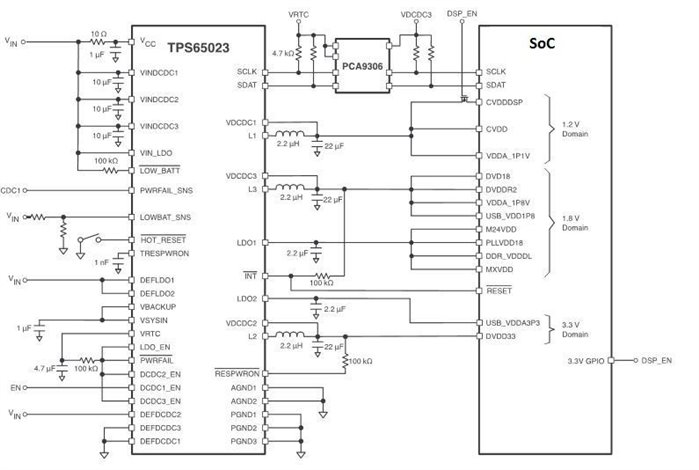SSZTB16 august 2016 TPS65023 , TPS65910

Example of PMIC Powering an SoC
As more and more designs are surpassing the capabilities of simpler microcontrollers, today I’m going to walk you through the basic considerations for powering a system on chip (SoC). The first thing you’ll need to do is pull up the data sheet or technical reference manual for the SoC you have selected. Within these documents are five conditions that can help you define the power scheme for your particular processor or SoC:
- Absolute maximum ratings. These ratings define the conditions that, if exceeded, will damage the device. If you’re worried about breaking your new processor, you definitely need to know what the device can tolerate
- Typical power domains. SoCs integrate features that often operate at different voltage levels, requiring separate supplies. For instance, ARM devices often use a dedicated power supply for the ARM core separate from the SoC domain, which contains the rest of the bells and whistles integrated into the device. Other common domains include the input/output (I/O) domains for logic and communication peripherals, and the memory domain, which will depend on the type of memory selected. You’ll find specific voltages listed in the data sheet under a title similar to “Recommend Operating Conditions,” often containing some combination of minimum, typical, and maximum values.
- Power-sequence requirements. Not only do you need to provide adequate voltages to the required domains, but you also need to ensure that you enable and disable the internal domains in the correct order to avoid non-ideal behavior such as current leakage or latch-up conditions. This is often accomplished by delaying the state change of specific domains until the prerequisite domains have stabilized or surpassed a specific voltage. Sometimes power-sequencing requirements will list the order in which to supply the domains, while other data sheets may detail the maximum allowable voltage differences or the minimum required delay times between specific domains. You can create delays by enabling regulators with a previous supply or corresponding power-good signal, with specific delay times accomplished through resistor/capacitor RC networks and additional logic gates. Alternatively, reference designs can assist you if your project has an aggressive schedule, and many power-management integrated circuits (PMICs) (like the TPS65910 PMIC) even have sequences pre-configured for various devices.
- Current requirements. Defining the expected currents for the application will greatly simplify the selection process when choosing acceptable voltage regulators. If available, the absolute maximum supply currents will detail the most demanding conditions that a regulator should support. If these currents are not clearly defined within the datasheet, or the values presented seem excessive for your application, you might be able to find an additional document online that contains power-consumption measurements for various operating conditions, which can help you set more realistic expectations for typical values. Often, you can group domains with equivalent voltages together as long as they do not violate the sequencing requirements. This flexibility for combining or separating domains enables you to redistribute load currents across available regulators.
- Additional features. Features like dynamic voltage scaling (DVS) and different modes of operation expand SoC functionality and can reduce power consumption when appropriate. You may not need these features for simpler designs, which could operate with discrete voltage regulators permanently configured for one voltage value. Other designs may be more consumption-conscious, however, and would benefit from a flexible power scheme that enables different operating modes such as sleep states or high-performance conditions. PMICs generally integrate multiple regulators into a single package that you can control on the fly, making them flexible for platforms that require separate voltage domains in a compact space. The added versatility of a PMIC often comes at a higher cost than discrete devices, but adaptable devices such as the TPS65023 are affordable for even cost-conscious designs, expanding the capabilities of the SoC compared to simpler power architectures.
Of course, you may need more details depending on the processor, but these generic guidelines can quickly help you understand the basic power requirements for a new platform. The number of unique voltage domains will correlate to the number of voltage regulators you need, and summing the individual current limits for grouped modules will define the power capability you need for shared supplies.
You can revisit specific parameters such as tolerances and transient conditions to help narrow down component selections once you have selected a few possibilities. Additionally, searching the datasheet or technical reference documents for keywords such as “must” and “require” can help spotlight other inconspicuous necessities.
Additional Resources
- Learn more about PCB design and layout strategies
- Learn more about the portfolio at TI.com/PMIC